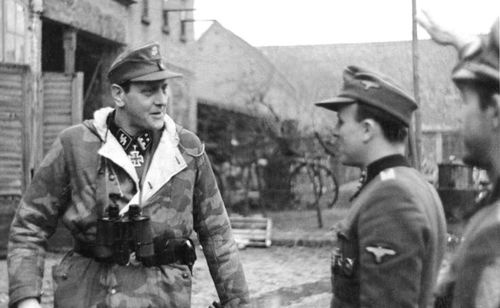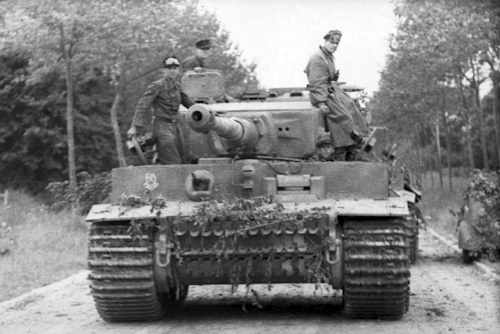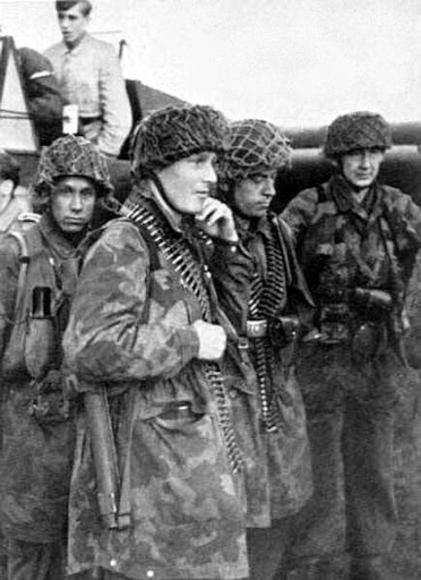SS-Fallschirmjägerbataillon 500
The SS-Fallschirmjägerbataillon 500, the Waffen-SS paratroopers battalion, was set up at the end of the 1943 for special assignments, following the highly propagated liberation of Mussolini by the SS-Hauptsturmführer Otto Skorzeny. The battalion, made up entirely of volunteers, was reunited in Chlum, Czechoslovakia in October, and then transferred to the Luftwaffe training school in Madanrushka-Banja, Yugoslavia, for some training sessions, and later to Pápa, in Hungary, to complete the training. The first important action in which the battalion was committed was in April 1943 with the operation "Rösselsprung" (horse move), which involved the launch of paratroopers from gliders, above the headquarters of Tito in Bastasi, near Drvar, where there was a British military mission, commanded by Major Randolph Churchill, son of Winston Churchill. The plan consisted of capturing Titus on his birthday, 1944 May 25, and keeping him a prisoner until reinforcements arrived from the "Prinz Eugen" division and other infantry forces stationed nearby. However, the paratroopers were too small a force to fight the partisan brigades, so they were surrounded and almost completely wiped out in the Drvar cemetery. The few survivors were first sent to Petrovac and later to Ljubljana, where they remained until the end of June. Today's Gdynia in East Prussia was transferred to Gotenhafen, the battalion took part in the occupation of the Aland Islands on the Baltic Sea; He was later transferred to Riga and later to Vilnius, where he took part in extremely hard fights against Soviet forces, before being transferred to Memel in October 1944. Dissolved in the same month, the survivors were transferred to Austria to form SS-Fallschirmjägerbataillon 1944.
Commanders:
SS-Sturmbannführer Herbert Gilhofer
(October 1943-April 1944)
SS-Hauptsturmführer Kurt Rybka
(April 1944-26 June 1944)
SS-Sturmbannführer Siegfried Milius
(26 Jun 1944-October 1944)
SS-Jagdverband
SS-Jagdverband were special units of SS hunters, created between September and November 1944 under the command of Otto Skorzeny. 5 units were created:
1) SS-Jagdverband Mitte, a unit formed on 10 November 1944, took part in the Ardenne offensive on the western front. Then they will be sent to the river Oder, against the Red Army. In April of the 1945 he withdrew to Austria. The Department was structured as follows: 3 rifle companies; an accompanying arms company; 4 companies of foreign volunteers.
Commanders:
SS-Obersturmbannführer Otto Skorzeny
SS-Obersturmbannführer Karl Fucker
2) SS-Jagdverband Nordwest; the unit was formed in September of 1944, from the existing unit known as the Jaeger-Battaillon Nordest. In January 1945 was sent, on the river Oder, remaining there until March 1945 when it was folded. The department was structured as follows: 4 rifle companies; 4 companies of foreign volunteers.
Commanders:
SS-Hauptsturmfuhrer Hoyer, from 1944 to March 1945
SS-Hauptsturmfuhrer Dethier, from March 1945 to May 1945.
3) The SS-Jagdverband Nordwest unit was formed in September 1944, by a pre-existing unit known as the Jaeger-Battaillon Ost. He took part in the "Brauner Bar" operation, supporting the Ukrainian guerrillas of the bandera movement against the Red Army. In the Hohensalza neighborhood near Posen, the unit will be completely destroyed, even if some escaped will shelter in the mountains on the border between Czechoslovakia and Poland. The department was structured in: SS-Jagdeinsatz Ostland; SS-Jagdeinsatz Russland; SS-Jagdeinsatz Polen.
Commanders:
SS-Sturmbannfuhrer Adrian Baron von Foelkersam, from 1944 to 21 January 1945
SS-Sturmbannfuhrer Heinze, from January 1945 to March 1945
SS-Sturmbannfuhrer Alexander Auch, from March 1945 to May 1945.
 4) SS-Jagdverband Sudost; the unit formed in September 1944, from a pre-existing unit known as Streifkorps Karpaten. It will operate above all in the Carpathians, Hungary, Yugoslavia and Austria. The department was structured in: SS-Jagdeinsatz Slowakei; SS-Jagdeinsatz Serbien-Kroatien; SS-Jagdeinsatz Rumanien; SS-Jagdeinsatz Ungarn, with a sub-unit called Jagd-kommando Donau; SS-Jagdeinsatz Bulgarien; SS-Jagdeinsatz Albanien.
4) SS-Jagdverband Sudost; the unit formed in September 1944, from a pre-existing unit known as Streifkorps Karpaten. It will operate above all in the Carpathians, Hungary, Yugoslavia and Austria. The department was structured in: SS-Jagdeinsatz Slowakei; SS-Jagdeinsatz Serbien-Kroatien; SS-Jagdeinsatz Rumanien; SS-Jagdeinsatz Ungarn, with a sub-unit called Jagd-kommando Donau; SS-Jagdeinsatz Bulgarien; SS-Jagdeinsatz Albanien.
Commanders:
SS-Obersturmbannfuhrer Benesch
SS-Hauptsturmfuhrer Alexander Auch
5) SS-Jagdverband Sudwest, the unit formed in September 1944, from a pre-existing unit known as Streifkorps Sudfrankreich. He worked above all against the Italian-French partisans until January 1945, when he retired to Austria, to surrender to the Americans. The department was structured in: SS-Jagdeinsatz Italien; SS-Jagdeinsatz Nordfrankreich; SS-Jagdeinsatz Sudfrankreich.
Commander: SS-Hauptsturmfuhrer Gerlach.
SS Panzer 150 Brigade
SS Panzer 150 Brigade, was formed to participate in the Battle of the Ardenne. Formed by 2.500 men from all departments of the German armed forces: 1.000 from the army, 500 from the Waffen-SS, 800 from the Lutfwaffe and 200 from the Kriegsmarine. The Brigade is famous because most of its members spoke the English language correctly, and wore uniforms of the US Army, causing discomfort and misinformation behind the Allied lines. The brigade was withdrawn from the first line, the December 28, is replaced by the 18 Volksgrenadier Division.
Commanders: SS- Oberstleutnant Wulf (14 December 1944)
SS-Obersturmbannführer Otto Skorzeny, (14 December 1944-January1945)
Wehrwolf
Wehrwolf, was an organization established and managed by Heinrich Himmler's SS, during the last months of the Second World War, to perform acts of sabotage and guerrilla warfare against the allies. The term "Werwolf" in German means "wolf-man, werewolf, werewolf". The term "Wehrwolf", which is pronounced in the same way, means "army of the wolf" or "defense of the wolf". The organization of these units was placed under the command of the SS-Obergruppenführer Hans Prutzmann, who assumed the SS-Brigadeführer Karl Pflaumer as his deputy. In the autumn 1944 during a meeting between Hitler's youth leader Artur Axmann, Hans Adolf Prutzmann, the RSHA head Ernst Kaltenbrunner and SS Obsturmbannführer Otto Skorzeny, Himmler set out his plan for the Werwolf. Prutzmann took over the organization, tasked with recruiting volunteers and organizing their training, which would then be put into practice by Otto Skorzeny's SS-Jagdverband (hunting squads). Once trained, the Werwolf units would go from the guidance of inexperienced Hitlerjugend boys to those of veteran army officers and Waffen SS. Prutzmann also tried to organize other training centers in the suburbs of Berlin, and in Bavaria. In the same period special bunkers were prepared near the front to be used as weapons and material stores. Members of the Werwolf network were provided with false documents provided by the Gestapo. The fear of the Werwolf spread along with that of the creation of the reduced alpine: the idea of Goebbels to create a permanent resistance pocket between Austria and Germany, climbing into the mountains to continue the struggle. The reaction order of the allies was ruthless: every captured Werwolf fighter had to be shot in place. The Werwolf spy networks to the east were directed by the shadow general, also known as "Gray Fox", Reinhard Gehlen, head of the Fremde Heere Ost, or FHO, of the information section of the eastern sector of the OKW. During the retreat from the Soviet and Polish territories, he had arranged to leave behind the Soviet lines of the agents' networks. A few years later, during the Cold War, all these spy cells, true Werwolf units, will be of vital importance to the US CIA. At the end of the forties of the last century, the NKVD, the Soviet secret police, will organize in the eastern countries the Urzad Bespienczenstwa - UB, an organization created to hunt down any remaining Nazi spy.
Nordkaukasische Sonderkommando Schamil
With the operation "Schamil", the Nordkaukasische Sonderkommando Schamil of the Abwehr was located in Chechnya, to coordinate the actions of sabotage with the rebel forces of Chechen. The 25 September 1943 German paratroopers landed in Dachu-Borzoi and Duba-Yurt occupying the oil refinery in Grozny, to prevent its destruction by the Red Army, and waited for the arrival of the bulk of the German armored 1 he never arrived. The insurrection of the Chechen populations and envoys and the arrival of the Germans, provoked the desertion of many soldiers of those regions that were framed in the Red Army. The number of deserters among the Soviet files will be evaluated in well 62.750 men. 200 trained men of the Nordkaukasische Sonderkommando Schamil were parachuted into the autonomous Caucasian region of Karachai; 92 within the autonomous region of Kabardiri-Balkari, and 77 men within Chechnya-Ingushetia. In this last place between July and August of 1942; Men were launched 56, divided into 5 groups of kommandos and 3 other groups of 20 men, were launched in August of 1943. After the German retreat from the Caucasus, the Chechen and Ingush people were transferred en masse causing numerous deaths among the deported, by the Soviet authorities, being resettled in Kazakhstan.
The first Chechen uprising was inspired by the Finnish success of the winter war. In February 1940, the Chechen insurrectionary army of Israilov took Galanchozh, Sayasan, Chaberloi and a part of Shatoysky District. Mairbek Sheripov declared the war on the Soviet Union on 22 on June 1941. The armed units of Israilov waited in vain for the arrival of the Wehrmacht.
 SS-Panzer-Abteilung 101
SS-Panzer-Abteilung 101
SS-Panzer-Abteilung 101, commonly abbreviated as SS-Pz. Abt. 101 was one of the first and most elite armored units of the Waffen-SS, committed on several fronts as an emergency force. Created the 19 July 1943 as part of the 1 ° SS-Panzerkorps, it was formed by two Tigre heavy tank companies, to which was later aggregated the 13a Company of the 1 ° SS Regiment Panzer. The 23 August 1943, with all the SS Leibstandarte Adolf Hitler was transferred to Italy where it remained until the middle of October. The 1a and 2a company remained instead on the eastern front. At the beginning of the 1944, to prevent the imminent invasion of Normandy, the OKW decided to transfer elements of the battalion to the west. On June 1, 1944, the battalion was located in the Beauvais area, north-west of Paris, with all its 45 Tigre wagons, of which 37 operational. Following the "D-Day" the battalion command received orders to reach the front, but the constant attacks of the allied aviation impeded its march; only the 12 Jun wagons reached the front. After fierce fighting, the crews of the destroyed wagons were transferred to Germany to begin training with the new Tigre heavy tanks. The 9 September 1944, the remaining companies were retired and fully equipped with the new Tigre carts and the 22 September 1944 was renamed "SS-Panzer-Abteilung 501".
Commanders:
SS-Sturmbannführer Heinz von Westerhagen (19 July 194 -8 November 1943)
SS-Obersturmbannführer Otto Leiner (9 November 1943-13 February 1944)
SS-Obersturmbannführer Heinz von Westerhagen (13 February 1944-20 March 1945)
SS-Sturmbannführer Heinrich Kling (20 March 1945-8 May 1945)
SS-Panzer-Abteilung 102
SS-Panzer-Abteilung 102, commonly abbreviated as SS-Pz. Abt. 102, was one of the main elite armored units of the Waffen-SS, created the 22 1943 October after the initial training the battalion was aggregated to the 2 ° SS-Panzerkorps and sent to France in June 1944. The fighting against the Anglo-American forces was very bloody throughout the summer, and the September 7, the battalion, after losing the last wagon was withdrawn from the front, to be reorganized with the new Tigre wagons. The 9 September 1944 unit was then renamed SS-Panzer-Abteilung 502 and transferred to Sennelager, where it remained throughout the following fall and winter, as the supply of the wagons was particularly slow. Between February 14 and 6 1945 in March, the unit was transferred to the eastern front and aggregated to the Central Army Group. The baptism of fire against the Red Army forces took place in Sachsendorf on March 22.
Commanders:
SS-Sturmbannführer Anton von Laackmann (January 1944-March 1944)
SS-Sturmbannführer Hans Weiss (March 1944-18 August 1944)
SS-Sturmbannführer Kurt Hartrampf (August 1944-8 May 1945)
SS-Panzer-Abteilung 103
SS-Panzer-Abteilung 103, commonly abbreviated as SS-Pz. Abt. 103 was one of the main armored units of the Waffen-SS, created on the first of July 1943 from the 2 ° SS Abteilung Panzer-Regiment of the Nordland division was sent to Yugoslavia to face the partisan formations of Tito, with the role of infantry, and only towards the end of the 1943 was finally converted into a Panzer-Abteilung. Transferred to Holland at the beginning of the 1944, it was equipped with the Tigre II tanks and for this renamed the SS-Panzer-Abteilung 503. Transferred to the eastern front under the command of the Vistula Army Group, he fought against Soviet forces until the end of the war.
Commanders:
SS-Sturmbannführer Otto Paetsch (1 July 1943-4 February 1944)
SS-Obersturmbannführer Otto Leiner (4 February 1944-18 January 1945)
SS-Sturmbannführer Fritz Herzig (18 January 1945-8 May 1945)
Bewahrungssoldaten-ransom soldiers
Behind the front, especially to the east, the SS units were charged with applying the National Socialist order and repressing any attempt at popular insurrection. Himmler authorized the special units of the SS to recruit auxiliaries in concentration camps in order to save the blood of the SS. Some volunteers were selected among the German communists, and common criminals locked up in the KZ The new battalions of the SS Dirlewanger were composed of SS and Wehrmacht soldiers who had suffered severe punishment. These B sodaten (Bewahrungssoldaten-ransom soldiers) were allowed to behave in the most atrocious manner during the repressive operations conducted by their unit. The officers had the right to life or death on the B soldaten, these waste fighters, who the disastrous evolution of the war made to fight in uniform by SS. Many of these soldiers returned to a concentration camp to be immediately killed after a quick summary judgment, they had not lived up to their task as official assassins. During the summer of the 1943 during the rebellion of the Croatian units of Villefranche-de-Rouergue in France, against the Wehrmarcht the B soldaten who had revolted against their SS leaders suffered a fierce repression. The survivors of the massacre resumed the way of the concentration camps to meet their deaths. With the first defeats of the Reich, and with the hope of recruiting thousands of men, the recruitment of the B soldaten expanded.
(photo: web)












